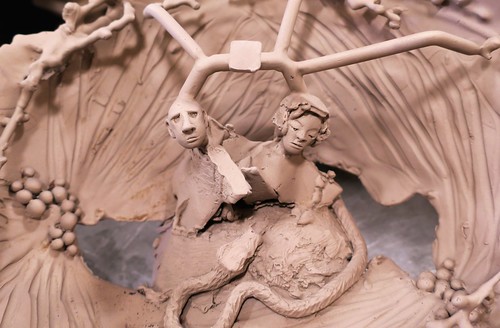 |
| Making of a sculpture, Art Castings of Colorado. May 2016. |
A surprise to me about Colorado - the Denver-Fort Collins corridor, anyway - is the abundance of sculpture in public spaces.
Based on lightweight research, it appears there are three art foundries in the small town of Loveland. There are others in Berthoud and Paonia.
I was lucky enough to be able to tag along with an already-scheduled tour group of Art Castings of Colorado, thanks to the generosity of the foundry and the group leaders.
It takes a village ...
I never put much thought into how a sculpture achieves its final state of being.
So it was a revelation to learn how many painstaking steps - and how much post-production artistry - it takes to render a sculptor's raw form into its final, durable maturity.
Below is a flow chart that describes the process. Begin with "pattern making," which is the first meetup with the sculptor's newborn chick.
 |
| Foundry flow chart. Credit: ZHY Casting. |
Below is a slide show of the sculpture-finishing process, roughly in sequential order of the steps:
Foundry artists
Not long ago, I read an interview with a literary translator, Dr. Margaret Sayers Peden. Of working with the original writers whose work she was translating:
"[I worked with] authors who knew English very well and were happy to answer questions and untangle problems, with authors who knew no English at all and preferred not to be involved, and with authors who knew a little English but thought they knew it as well as their own, and thus were sure they were able to choose the best [English words] for their book."
 |
| Making of a sculpture, Art Castings of Colorado. May 2016. |
There seem to be two dimensions of art foundry work:
- Technical knowledge and skill in the mechanics of the process; and
- Artistic sensibility and skill in "translating" the sculptor's malleable form into the hard form.
 |
| Making of a sculpture, Art Castings of Colorado. May 2016. |
The tour guide noted that some sculptors, once they feel assured there is a shared understanding of desired outcomes, release the process to the foundry's experts. Some sculptors want to be hands-on with all steps that involve creative judgment. In the latter case, sometimes this works well and sometimes it doesn't. The artistic eye, paired with technical knowledge, for creating a sculpture is different from the creative eye and technical knowledge in the foundry process.
Fascinating.
I'm tempted to work in a metaphor of baking a multi-layered, elaborately-decorated cake, and the multitude of different skills, ingredients, equipment, and energy that goes into that, but we've both got lives to lead.
Peculiar parts and pairings
One of the rooms at the foundry is a vast work space. Works in progress sit on shelves, table tops, on pallets, or on the floor.
Sometimes the results are amusing, like this one:
 |
| Making of a sculpture, Art Castings of Colorado. May 2016. |
My God! My balls! What are they doing over there!?
Sometimes they set up a cognitive dissonance for me that is uncomfortable:
 |
| Making of a sculpture, Art Castings of Colorado. May 2016. |
On one hand, I see a smiling child, so I know the final product will be a happy one. On the other hand, I see dismemberment and violence, a reminder of the dark history we Americans share.
There are the odd historical juxtapositions that feel whimsical:
 |
| Making of a sculpture, Art Castings of Colorado. May 2016. |
Finally ... Here is a piece going to its forever home:
 |
| Making of a sculpture, Art Castings of Colorado. May 2016. |

No comments:
Post a Comment